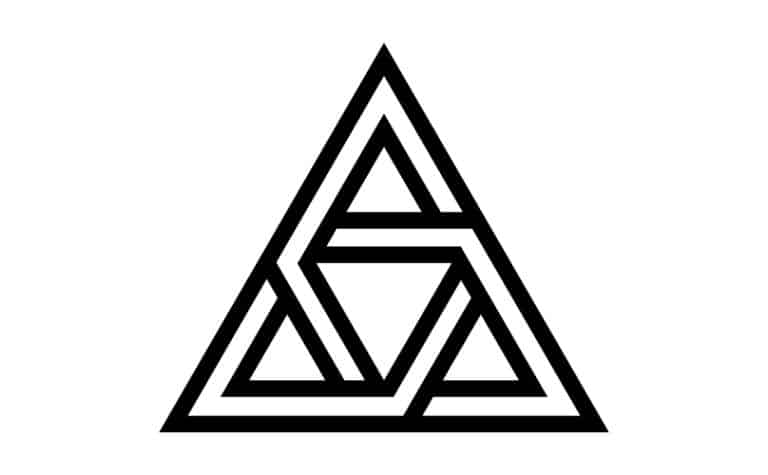Of all the memorable characters that make up the world of Norse mythology, one of the most intriguing is the all-father Odin.
He has a central role in many riveting tales and is instrumental in delivering transcendent messages about life and the universe.
So it comes as no surprise that many core symbols are closely associated with Odin, including the triskelion known as Odin’s Horn.
Odin’s Horn is one of the most recognizable Norse symbols, consisting of three interlocking drinking horns and symbolizing poetic inspiration and wisdom.
It is also a nod to Viking drinking customs and the camaraderie derived from them. As is often the case with Odin, it begins with a web of deceit.
As a celebrated symbol of the Norse people, Odin’s Horn has endured through many centuries.
It has appeared on ancient runestones that pre-date the Vikings, and over a thousand years later, it is a popular motif in today’s pop culture.
Like the god for which it is named, Odin’s Horn is a symbol full of intrigue. Read on to learn how it came to be through Odin’s obsession with the Mead of Poetry.
Also, see Is Odinsleep Found in Norse Mythology? to learn more.

Why Are There Three Horns in Odin’s Symbol?
The Odin’s Horn triskelion ranks among the most visually striking of Norse symbols, and the story behind its origin is equally compelling.
Among Odin’s most notable attributes is his mastery of Old Norse poetry. (Also see This Is Why Odin Sacrificed His Eye)
But he did not always have this rare and extraordinary talent; rather, in classic Odin fashion, he gained this gift through guile and deceit. Here’s how:
The most striking feature of Odin’s Horn is the interlocking of the three drinking horns, which are often depicted with the pointed tips (the non-drinking end of the horn) directed outward.
The number of horns in this symbol aligns with several important aspects of the Mead of Poetry narrative:
- There was once a being named Kvasir whose wisdom was unrivaled by any human or god
- Two dwarves named Fjalar and Galar murdered Kvasir and brewed a magical mead with his blood
- Anyone who drank this mead would be infused with Kvasir’s wisdom and instantly become a poet or scholar
- The mead came into the possession of a giant named Suttung, who, along with his daughter Gunnlod, guarded their enchanted brew closely
- Odin became aware of the Mead of Poetry and yearned to partake in its magic to enhance his scholastic prowess
- Upon hearing of the mead’s whereabouts, Odin conspired to steal the magical elixir
- Transforming himself into a handsome wanderer, Odin seduced Gunnlod into allowing him three sips by promising to be her lover for three nights
- The all-father consumed three entire vats’ worth (the entire lot) of mead and flew away in the form of an eagle, bringing the Mead of Poetry back to Asgard (with a few drops falling in Midgard along the way) [1]
- To seduce Gunnlod, Odin (taking the form of a charming stranger) agrees to spend three nights with her
- In exchange, Gunnlod allowed Odin three sips of mead
- The mead was stored in three vats (in some versions, the vats are horns) named Odroerir, Bodn, and Son [2]
The fact that there are three drinking horns comprising Odin’s Horn is not arbitrary; the number three is considered a divine number in Norse mythology. [3]
Other prominent instances of the number three appearing in ancient Norse myths and legends include:
- Three gods, Odin, Vili, and Ve, created the first humans
- Three Norns, Urd, Verdandi, and Skuld, determine the fate and destiny of every living being, including the gods
- Yggdrasil, the Norse tree of life, has three massive roots
- Three offspring of Loki are central figures in Ragnarok: Hel, Jormungandr, and Fenrir
Lastly, the significance of the three drinking horns comprising Odin’s Horn can also be extended to the celebration of drinking itself, which was an important aspect of Viking gatherings and ceremonies. [4]
Among his many titles, Odin is also the god of alcohol, so this symbol is representative of the linkage between Odin and his followers and the sense of camaraderie fueled by the consumption of mead and the like.
Interested in Norse Mythology? See 14 Great Books on Norse Mythology that explain the gods, heroes, and villains of these ancient stories of Scandinavia.

Who is Odin in Norse Mythology?
Norse mythology is full of fascinating, one-of-a-kind characters, and leading the way as the most enigmatic of them all is Odin, the king of the Aesir gods.
He has meant many things to the Norse people through the centuries, and the fact that he has over 150 nicknames (each indicative of a particular power or attribute) is a testament to his enormous stature. [5] (Also see Why Does Odin Have So Many Names and What Are They?)
He is the all-father, but in so many ways, Odin’s personality traits and personal exploits indicate otherwise. He is as quirky and eccentric as any deity can be, but his greatness is beyond question.
From the creation narrative to Ragnarok, it is fair to say that Odin is Norse mythology personified.
Starting with his appearance, Odin’s physical features are not what one would expect of a god of his lofty status (although he has the power to shapeshift and transform himself into any desired form). [6]
He is often depicted in the most unassuming of ways, with:
- A patch over one eye (he famously gouged out one of his eyes in exchange for a sip from Mimir’s Well, also known as the Well of Knowledge)
- A long, scraggly beard
- An oversized cloak or gown-like garment
- His signature wide and floppy-brimmed wizard’s hat
Odin is also famous for his animal companions, most notably his two ravens, Huginn (“thought”) and Muninn (“memory”), who serve more as his reconnaissance team than his pets by scouting the earthly and godly realms and reporting their observations to him.
He also rides around on an eight-legged horse named Sleipnir, who can gallop with lightning speed on land or in the air. (Also see Do People Still Believe in Odin?)
But what makes Odin the greatest deity in Norse mythology is his omnipresence. He plays a central role in all of the core narratives that form the foundations of Norse spiritual and cultural practices.
Though the breadth of the Norse people’s reverence for Odin is encompassed so many aspects of their existence, these are his key attributes:
- God of War – although he does not strike an imposing figure physically, he is closely associated with elite Viking warriors, including the infamous berserker
- God of the Dead – as the overseer of Valhalla, Odin selects fallen Viking warriors with the aid of his Valkyries, to join the ranks of his einherjar in preparation for the cosmic battle royale that will occur during Ragnarok (a battle which the fates have pre-determined that they will lose)
- God of Poetry – Odin famously stole the Mead of Poetry to share the gift of verse with his fellow gods and humankind
- God of Knowledge and Enlightenment – Odin is consumed with an insatiable thirst for knowledge and enlightenment, as exemplified by gouging out one of his eyes in exchange for a sip from the Well of Knowledge and by his self-sacrifice at Yggdrasil, the Norse tree of life (hanging for nine straight days while impaled by his spear), to unlock the secrets of ancient runes [7]
The list of Odin’s powers is extensive, and the matters over which he has dominion are equally wide-ranging.
But as far as issues of the greatest consequence, when he is not wandering about in pursuit of greater knowledge, Odin can be found in the company of great Viking warriors, preparing for Ragnarok while knowing full well they will not live to see the rebirth of the universe. (Also see The Norse Tree of Life: A Fascinating Vikings Symbol)
Did the Vikings Worship Odin?
Odin was likely not worshiped by as broad of a swath of the Norse population as his son Thor who was the most popular of all mythological figures.
But as the god of war, the dead, and of wisdom and enlightenment, the all-father did have a loyal following among certain segments of Viking society, namely:
- Viking rulers, including kings in the later stages of the Viking Age and chieftains in the early stages, who would have revered Odin’s wisdom and sought his sage counsel
- Viking warriors, who would have sought his favor with the hope that by dying an honorable death, they would awaken in the majestic halls of Valhalla
- Viking poets and scholars, who by calling upon the intellectual and poetic gifts of the all-father, might find their own artistic or scholastic inspiration [8]
Interestingly, Odin’s own act of self-sacrifice hanging from the branches of Yggdrasil tree to learn the secrets of ancient runes may be the basis for real-life rituals involving human sacrifice in his honor by his Viking worshipers.
While Odin’s base of worshipers may have been lacking in breadth or number, it certainly comprised the elite and powerful of Viking society.
Final Thoughts
Odin’s Horn is a visually striking symbol that represents one of the all-father’s most cherished attributes, the divine gift of poetry.
References:
[1] Source
[2] Source
[3] Source
[4] Source
[5] Source
[6] Source
[7] Source
[8] Source
